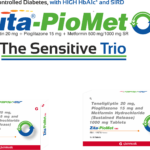Type 2 diabetes- new and unique clusters identified in Indians. Researchers from Scotland-based University of Dundee have helped identify distinct forms of type 2 diabetes in South Asians, a development with important implications for prognosis and management of diabetes of the disease.


The majority of knowledge surrounding diabetes and its cardiovascular complications has been accumulated from studying white populations with Western European ancestry, despite the fact that diabetes in Europeans is very different to Asians. This is referred to as the ‘Asian Indian Phenotype’.
This situation led to the creation of INSPIRED, a £7 million Dundee-led project that seeks to improve diabetes outcomes in India by working to better understand who gets diabetes, how it progresses, why some people respond better than others to treatments, and why some patients develop complications.
INSPIRED sees University of Dundee’s world-leading expertise in the use of medical records to deliver improved care in diabetes ‘twinned’ with the large patient data set (covering over 450,000 Indian diabetic patients) collected by Dr Mohan’s Diabetes Specialities Centres, the largest clinical network of diabetes care in India.


Professor Colin Palmer, of University of Dundee’s School of Medicine, said, “These findings appear to be unique to Indians as they differ significantly from the findings published earlier in the European population. We recently reported that Asians respond better to DPP4 inhibitors and SGLT2 inhibitors. The findings of this study confirm the greater insulin secretory defect and the younger age at onset of diabetes in South Asians.”
Classifying Asian Indians with type 2 diabetes into phenotypic clusters provides insights into the pathophysiological processes driving diabetes in this ethnic group, which could help in predicting the risk of complications and in focusing more attention on individuals with the highest risk of developing complications.
The Asian Indian Phenotype is characterised by high levels of abdominal fat and increased insulin resistance even at low levels of body-mass index (BMI) and this has been suggested to be the main reason for increased propensity to develop type 2 diabetes at younger age. Recent studies from the INSPIRED team showed that beta-cell dysfunction occurs quite early and rapidly in Asian Indians.
The four clusters identified are Severe Insulin Deficient Diabetes (SIDD), Insulin Resistant Obese Diabetes (IROD), Combined Insulin Resistant and Deficient Diabetes (CIRDD) and Mild Age-Related Diabetes (MARD). SIDD and MARD correspond to the clusters identified in the Europeans populations, while the other two are novel subgroups unique to the South Asians.


The characteristics of the clusters did not differ when split by gender and duration of diabetes, which shows the stability of the clusters. Lead author Dr V. Mohan, Chairman of Dr Mohan’s Diabetes Specialities Centre and President of Madras Diabetes Research Foundation, says, “These subgroups of type 2 diabetes have implications as far as treatment is concerned and the choice of anti-diabetic drugs. For example, the severely dependent diabetes variety would probably respond better to sulfonylurea agents or secretagogues or may need insulin, whereas the insulin resistant variety would respond better to an insulin sensitiser like metformin.”
The research was funded by the National Institute for Health Research (NIHR). The NIHR was established in 2006 to improve the health and wealth of the nation through research, and is funded by the Department of Health and Social Care. In addition to its national role, the NIHR supports applied health research for the direct and primary benefit of people in low- and middle-income countries, using UK aid from the UK government.











